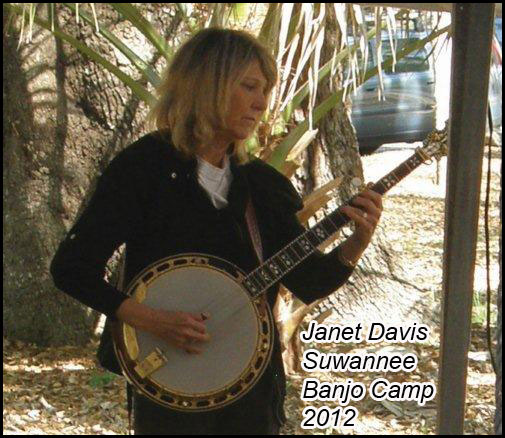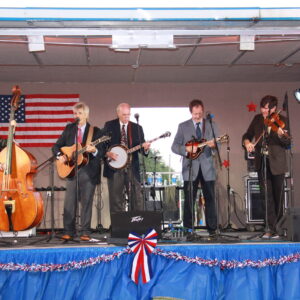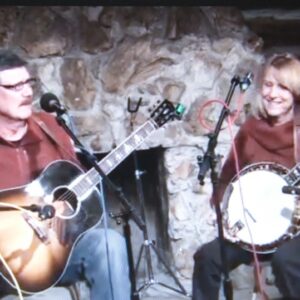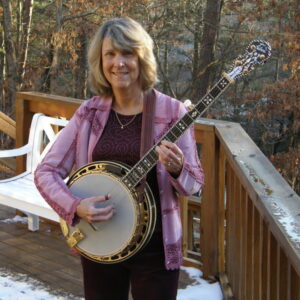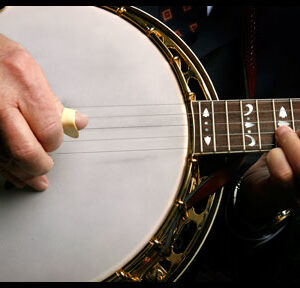Description
BACK UP
By Janet Davis
Back Up Quiz from 2011
The primary purpose of the following quiz is to review many of the terms, techniques, and basic principles involved in playing back up on the banjo. Although there may be more than one potential answer for a question, only one answer will qualify as correct for each question. Do your best to choose the answer which you feel best pertains to playing effective back up. A key appears at the end of the quiz,so that you can check your answers.
1. Back Up is:
a. The intelligent thing to do when meeting a skunk.
b. What a cat raises when it is mad.
c. Accompaniment involving a combination of rhythm and chords, which is played by the banjo while a person is singing, or while another instrument is playing the tune or melody to a song.
2. When playing back up, the banjo player should:
a. Hold the banjo behind his back.
b. Compete with the lead instrument to show off his fancy licks.
c. Play more quietly than the lead instrument with the primary intention of complimenting the lead instrument, and therefore, the overall effect of the song.
3. The key to effective back up is:
a. To put diapers inside the resonator of the banjo.
b. To LISTEN–to the other instruments, to the style of the song, to the rhythm, and to the overall effect being produced. Strive for balance.
c. Read Janet Davis’ column in Banjo Newsletter.
4. Lead instrument:
a. A term used to indicate the instrument which is playing
the tune (melody) to the song. (The lead instrument is the
focus of attention for which all of the other instruments
are working.)
b. A very heavy instrument made from fishing weights.
C. The instrument that is ahead in a race.
5. When a fiddle or mandolin player plays the lead break, the banjo player frequently:
a. Stops playing.
b. Makes faces.
c. Plays roll patterns and/or licks on the deep tones of the banjo to balance the higher timbre of those instruments.
6. Vocal back up is:
a. Yelling chord changes to a new band member.
b. Playing accompaniment for a person who is singing.
c. Moving away from an off key singer.
7. Timbre is:
a. A logger’s warning that a tree is about to fall.
b. The tone quality of an instrument.
c. Something an angry person may lose.
8. Up the neck:
a. From around the 5th to the 22nd fret of the banjo.
b. Where you feed a giraffe.
c. A polite place to tell a person to stick something.
9. Back up is often played up the neck:
a. To balance the deep tones of the dobro or guitar;
To create a counter melody with the fiddle or mandolin;
To increase the tension of the song as it progresses.
b. By people with very short arms; By vain, nearsighted people.
c. When the capo is on the 7th fret.
10. When the banjo is played up the neck, the strings should be picked:
a. Behind the bridge.
b. Behind the nut.
c. With the right hand placed near the neck of the banjo,— away from the bridge. This results in a mellower timbre, and softens the harsher effect of the higher pitches.
11. Chordal Improvisation:
a. Myrtle Improvisations’s Brother.
b. An incurable disease.
c. The art of playing spontaneously without the aid of tablature or a prearranged arrangement. Most back up is a form of chordal improvisation.
12. A chord is:
a. A combination of 4 tones which blend harmoniously when sounded together. Chords are the basis of all songs.
b. A piece of rope used for a banjo strap.
c. A large quantity of wood.
13. A major chord is:
a. An important chord.
b. A chord which has been promoted from captain.
c. A chord which is formed by playing the 1st, 3rd, and 5th tones
of the major scale named for the chord. (Most bluegrass
songs are built primarily with major chords, i.e. G,C,&D are
major chords.)
14. All major chords can be formed on the banjos:
a. Upside down.
b. With the right hand.
c. In any of three different left hand positions:
The “F” Position The “D” Position The “Barre” or “G”
(root position) (1st inversion) position
(2nd inversion)
15. Rolls are:
a. Homemade biscuits.
b. Right hand picking patterns which can be played on the banjo while holding any chord position with ‘the left hand. Roll patterns are frequently used to provide the back up for the fiddle, the mandolin, and for singing.
c. Somersaults performed while playing the banjo.
16. Licks are:
a. A form of punishment.
b. What a person sometimes does with his fingers after eating something sticky.
c. Patterns which are played as back up for specific chords. The same lick can be used in many different songs, as long as it is played for the correct chord.
17. Fill-In Licks are:
a. Licks which are used in back up to fill in the pauses at the end of the phrases, (i.e. when the vocalist takes a breath). Generally, these are played a little louder than the rest of the back up.
b. Licks which are used to keep the ice cream from melting down the cone.
c. Square dancing steps.
18. Vamping is:
a. A technique often used by a vampire
b. The technique of pinching block style chords with the right hand, followed by partially releasing the tension on the strings with the left hand.
c. The opposite of vumping.
19. Vamping can be used effectively: a. Only in Transylvania. b. As back up for any instrumental or vocal lead. It is frequently the primary style of back up used for fast instrumental breaks, (especially for guitar and dobro). c. When vumping is inappropriate.
20. Slides are:
a. Houseslippers.
b. Playground equipment.
C. Left hand techniques frequently used with the vamping style of
back-up. (When the left hand moves from one chord position
to another, it slides at least one finger (often the ring finger) along the string(s) to guide the ear of the listener into the new chord position.)
21. Passing tones are:
a. “Hello!”, “How are you?” as well as “Have a good day!”.
b. Tones located in a scale between two “chord tones”. These are frequently used in back up, particularly when changing from one chord to another chord, to guide the ear of the listener into the new chord. These non-chord tones act as connective links when the..music.travels from one chord tone to another.
c. Tones that have eaten too many beans.
22. Tension is:
a. Often created by the back up as a song progresses in order
to intensify the power of the overall effect of the song.
This is often accomplished through the use of more active
rolls and licks, and by playing up the neck of the banjo.
b. One more than ninesion.
c. All that is left of at-tention after a long lecture.
d. The feeling a banjo player has before a banjo contest.
23. Syncopation is:
a. The opposite of goodcopation.
b. A temporary, but deliberate displacement of the regular rhythm, accent or meter; syncopation is a deliberate disturbance of the normal pulse of the meter of the song. This is a technique often used in back up to emphasize a specific passage in a song.
c. A minor medical problem.
24. Circle of Fifths:
a. Several whiskey bottles arranged in a circle.
b. Several 5-string banjos arranged in a circle.
c. The circular, clockwise arrangement of the twelve keys with each key being located five letters up the alphabet from-the preceding key. It presents the keys in their natural order, (i.e., adding one sharp with each new key). After twelve steps, the initial key is again reached. (Back-up chords in the reverse order along the circle, counterclockwise, are often used in bluegrass songs to smoothly lead the music from one chord in the song back to the home chord named for the key, as a sequence of V (5th) chords….(as in “Salty Dog”).
25. Key:
a. The tonal center of a song. In music, all of the tones in a piece tend to work for one particular tone. This tone is called the key. Likewise all of the chords in a song work for the chord which is named for the key. A piece will usually begin on the chord which is named for the key, and it will almost always end on the chord named for the key.
b. A type of cheese pie. (as in Key Lime).
c. Contains the answers to this quiz, (see below).
KEY
Answers: 1.c.; 2.c.; 3.b. (although c. is a close 2nd); 4.a.,(although
some people might argue that in bluegrass music, c. often applies); 5.c. (b. is rude); 6.b.; 7.b.; 8.a.; 9.a.; 10.c.;
11.c.; 12.a.; 13.c.; 14.c.; 15.b.; 16.c.; 17.a.; 18.b.;
19.b.; 20.c.; 21.b.; 22.a.; 23.b.; 24.c.; 25.a.
Score 4 points for each correct answer.
If you scored 100, and really knew the answers to all of the questions, you should be forming a band, if you don’t already play in one. If you only missed two or three questiona, you know the fundamentals of back up quite well and receive an A, as long as you answered question #1 correctly.
If you scored above 50, you -should be playing with at least one other instrument in order to work on you back up techniques. (If this isn’t possible, record lead breaks, and practice playing back up with your recordings.)
If you scored less than 50 points on the above quiz, vumping may be more appropriate!


